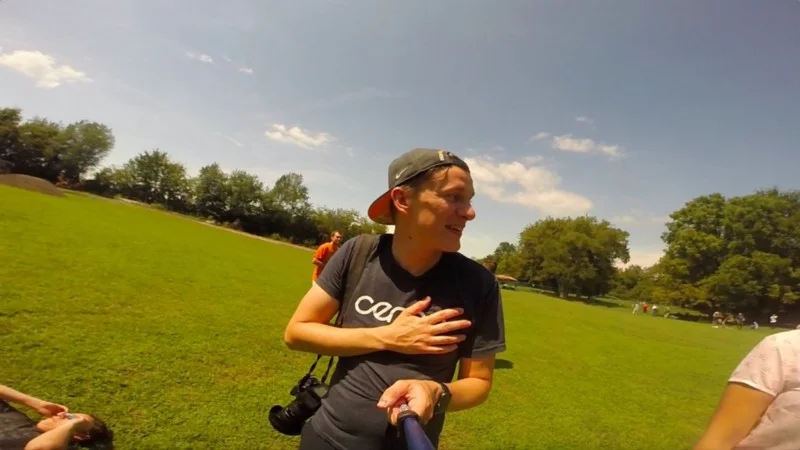In the past 6 months, I’ve gotten to completely rework and rewrite editorial statement for two different publications.
Long story, I’ll save it for another post.
But doing this exercise twice in a row, back-to-back has has helped me with something I think most brands who dip their toes in the publishing pool neglect—the why of what they do.
Most brands are pretty good about the “why” of their company as a whole, but when it comes to their publishing, it’s left as an afterthought. Most of the time, the mission of brand publishers is often flatly stated as “generate leads.”
Not exactly something that gets readers to buy in.
But a good editorial statement—whether it's something you share externally or only internally—is important. They outline the why of what you do, what you actually talk about (with enough flexibility to grow), and establish the voice (or the way) you do it. Done well, a great editorial mission should give anyone—reader, contributor, or otherwise—a perfect elevator pitch of what to expect from your publication.
A lot of editorial statements, both from brands and even respected publishers, fall flat. They’re too flexible/loose, or (and this is my least favorite) they use descriptive language that is anything but.
They say they’re “approachable, friendly, and smart” as if any brand in the history of the world has wanted to be “unapproachable, off-putting, and dumb.”
As I’ve worked on these statements myself, I’ve studied dozens of editorial statements and collected the ones I like best, and tried my best to emulate a piece of each. Each has a common thread: they clearly outline a why while also explicitly stating what they cover, while leaving enough room for flexibility. Which is a hell of a thing to pull off.
Note: I've edited some down to simplify. Not a big deal.
Marketplace
“Marketplace raises the economic intelligence of the country through the unorthodox story, the casual conversation and the unexpected angle on the news.”
Marketplace might have my favorite editorial mission of all. It’s one, dead simple sentence that explains exactly what to expect when you tune into the show, while also being highly flexible.
First we’ve got the why: “raise the economic intelligence of the country.” Listen to one episode of Marketplace and that mission comes through beautifully. They explain complex economic trends in a way that the layman can understand, without dumbing the subject down.
Then we get the what: “the unorthodox story, the casual conversation and the unexpected angle on the news.” This is my favorite part of Marketplace’s mission. There’s so much specificity AND flexibility in that statement. The show is framed up perfectly, whether you’re a listener or a new contributor. You can read that and know what direction to go in. Beautiful.
Inverse
“Inverse sparks curiosity about the future. We explore the science of anything, innovations that shape tomorrow, and ideas that stretch our minds. Our goal is to motivate the next generation to build a better world.”
I enjoy the Inverse editorial mission because it reaches an aspirational level the others don’t—what can I say, I’m an idealist. Looking at a few Inverse articles in isolation, you’d be forgiven for writing it off as just a sci-fi blog. But in aggregate, the mission starts to come together.
“Spark curiosity about the future” is certainly broad, but is still prescriptive. They cover “science… innovations… and ideas.” And their audience is “the next generation.”
While this aspirational tone can be fuzzy on the details, it captures the voice of the publication extremely well. The attitude of Inverse (and the audience, by association), is that a story about a sci-fi movie isn’t just about that movie—it’s an exploration of things to come.
The Verge
“The Verge is an ambitious multimedia effort to examine how technology will change life in the future for a massive mainstream audience.”
To be honest, The Verge’s missions statement didn’t really do much for me on first read. But after digging through this fantastic behind-the-scenes article from their Editor in Chief, Nilay Patel, about how it came into being, I printed it out and pinned it over my monitor at work.
What’s cool about this one is how it was born from a need to evolve, and leave ample room for growth moving forward.
Patel says that their old editorial mission didn't "capture the ambition of our team or the spirit of our brand." I think that's often overlooked by publishers and brands, as they opt instead to just say what topics they cover rather than communicate the spirit of the publication (which is why most people choose a brand of ANY kind).
In shaping this new statement, the team worked with a product manager at Vox Media (treating content as a product, imagine that) named Bo Kim. What they found was that much of the team felt the spirit of The Verge, but they all described it in different ways:
"When we asked the staff what The Verge was, they used a lot of the same nouns, and there was clearly a lot of passion, but there was no clear shared language amongst the team," says Bo. "It was almost like The Verge was a feeling."
That's not uncommon for any organization as they grow. When you first start out, the team is so small and motivated, that everyone "gets" it. But as you add more people, the culture tends to get diluted, unless you're intentional about it.
Here's Patel again (emphasis mine):
"While I love the idea of The Verge as a shared emotional delusion, we need to be a lot sharper and clearer if we’re going to extend our brand across every platform we want to live on. Not everyone will always see the totality of what we publish every day, after all. And our staff needs a set of common touchpoints to make sure everything we do in every format speaks to a shared vision. We have to define the emotion in order to make it stronger."
"Define the emotion in order to make it stronger." I LOVE that.
Reading this behind the scenes really helps illustrate how difficult a writing a simple sentence can be. Complex is easy. Simple is hard.
Here's another gem from Kim:
"Defining a mission statement forces editorial teams to focus on the impact they want to have and what their audience should rely on them for. Without that, our refresh would have been generic and soulless. The mission statement is our bellwether; it challenges us to stay smart, weird and beautiful in everything we do. It drives what the staff covers and the voice it uses, regardless of medium or platform. The whole point of a refresh is to enable The Verge’s vision, and the design system we create is a true and meaningful expression of that."
Curbed
“Love where you live—and improve it, all the time.
Obsessing about where you live is an overwhelming concern and endless pastime. Our mission at Curbed is to advocate for the places where people live, by celebrating, chronicling, and explaining everything you need to know about homes, neighborhoods, and cities.
If you love where you live, or want to, chances are you feel as strongly about the new park on your corner as you do about your lack of dishwasher, or the sustainable properties of a concrete building in the desert.”
Curbed is such a great publication. They’ve managed to effectively blend city level reporting with a national brand, which is no easy feat. And what I love about this editorial mission is how they acknowledge and embrace their broad coverage.
In my (very limited) experience writing out these mission statements, you typically hear a high level of discomfort with ambiguity from senior leadership—at least on the brand side. And I get it. They’re investing lots of money in this publishing thing, it feels outside their normal core competencies, and they want to know exactly what’s going on, how it relates to the business, and how it will neatly fit into the business plan so they can present it to investors.
“All these major publications are specific about what they cover and who they’re for! We need to be as well,” they protest. But then you read them editorial missions from their favorite publishers, and they’re all ambiguous. You ask them “What's your favorite magazine/channel/website about?” and they stumble for an answer.
Is The New Yorker about New York? Well… kind of, but not really?
Is Rolling Stone about music? Sure! Well… sometimes. But also lots of other things.
Point is, most of your favorite publications embrace ambiguity probably more than you care to realize, until you actually dig into what they cover and how they describe themselves. The conclusion you usually come to is that the best publications aren’t about a topic, but they’re for a very specific person.
Which brings me back to Curbed.
Curbed actively embraces this ambiguity as a strength, and lays out who it’s for instead of what it’s about: “If you love where you live, or want to, chances are you feel as strongly about the new park on your corner as you do about your lack of dishwasher, or the sustainable properties of a concrete building in the desert.”
Boom, beautiful. They’re gonna talk about dishwashers, parks, and even sustainable construction. Scroll the headlines on Curbed and you’ll see this broad coverage at play, but it all comes back to who it’s for, not what it’s about, and it suddenly all makes sense.
Now, to counter this ambiguity, Curbed ties everything together nicely with the stand alone tagline at the top: “Love where you live—and improve it, all the time.” Easy and quotable. Throw it on a t-shirt.
First Round Review
"We believe that there is powerful, untapped knowledge out there that can transform the way people build technology.
There's just one problem: It's trapped in other people's heads — people who are at the top of their fields, who rarely have time to share what they've learned (even when they want to). The Review is about liberating this knowledge to inspire and accelerate action. To deliver on this mission, we'll make you three promises...
1) We'll get out of the way and let experts speak directly to you about what they believe is most important. (That's why we choose not to use bylines.)
2) Every article will serve up tactics that you can use today to change your company and your career.
3) We will never be boring. The stories you find on here are crafted to teach, to engage and to stick.
Our first and only brand publisher on the list! First Round, if you’re unfamiliar, is a venture capital firm first and foremost, but their publication, First Round Review, is one of the most widely read sites in the startup world.
Their editorial mission, while a bit lengthy, is notable because of how well they marry the editorial mission to the mission of the company itself. It aligns with what they do and the way they do it, while still appealing to our aspirational senses to hook readers.
The Review takes a decidedly product-development style approach to this statement, which is appropriate given their status in the startup world. First they outline a problem: “There is powerful, untapped knowledge out there… (but) it’s trapped in other people’s heads.” Then there’s the solution: “The Review is about liberating this knowledge to inspire and accelerate action.”
Finally (and this is the cool part) is the “three promises” they make, which helps set expectations for what they’re going to talk about and how they talk about it: Let the experts talk, actionable information, and never boring.
While I disagree on the use of bylines (I don't think they get in the way, and they actually help readers develop relationships with your writers, which is a good thing), I can see where they're coming from with that decision.
Shameless Plug
That's all I got! If you dug this, I'm presenting on a webinar with Parse.ly soon where I'll talk about this and more. Click here to sign up, if you're into that sort of thing.























